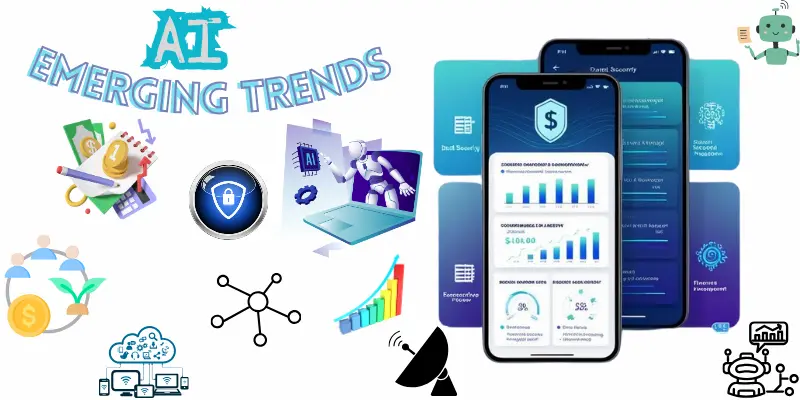How to Use AI Tools for Budgeting and Financial Planning
Published: 26/03/2025
Ever found yourself frustrated while trying to manage your finances? You’re not alone. In fact, a recent study showed that nearly 60% of people feel stressed when it comes to budgeting. It’s not easy—keeping track of expenses, sticking to a budget, and planning for the future can feel overwhelming. But what if there was a way to make all this simpler?
That’s where AI comes in. You might think AI is only for tech experts or big corporations, but it’s actually becoming an incredibly useful tool for everyday people who want to take charge of their finances without the headache. Imagine having a tool that helps you track spending, set goals, and even give you personalized advice—without needing a degree in finance.
In this post, we’ll show you how AI tools can help make budgeting and financial planning easier, faster, and more efficient. Whether you’re just starting to take control of your money or you’ve been managing finances for a while, these tools can help you stay on track and meet your financial goals.
Curious to see how it works? Keep reading to find out how AI can help you manage your money better.
| Key Insights |
|---|
|
Personalized Recommendations: AI tools dive into your spending habits to create customized budgeting and financial plans just for you. Real-Time Tracking and Predictive Analytics: These tools connect to your financial accounts, offering real-time tracking and smart forecasting. Automation and Integration: Say goodbye to routine financial tasks—AI automates them and pulls data from various sources for a seamless experience. |
What Are AI Tools for Budgeting and Financial Planning?
AI tools for budgeting and financial planning are apps and programs that use smart algorithms to analyze your spending habits, predict future expenses, and automate many of the tasks involved in managing your money. In simple terms, they work by collecting data about your finances—like how much you earn, how much you spend, and your saving patterns—and then use that information to help you make better financial decisions. These tools can do things like track your spending, suggest budgets, and even recommend ways to invest or save for the future.
There are different types of AI tools for personal finance:
- Budgeting apps: These automatically categorize your spending and help you stick to a budget.
- Financial planners: They help you set goals, whether it’s saving for a vacation or retirement, and keep track of your progress.
- Investment trackers: AI-powered tools that provide insights into your investment portfolio and suggest how you might improve your returns.
Why AI is the Future of Personal Finance
AI is quickly becoming a go-to option for people who want to simplify managing their money. One of the biggest advantages of AI tools is personalization. They learn about your financial habits and goals over time and give recommendations that are unique to your situation. Instead of a one-size-fits-all approach, AI can help create a plan that’s specific to your needs, whether that’s cutting down on dining out or saving more for long-term goals.
On top of that, AI tools save you a ton of time. They automate things like tracking expenses, making calculations, and even predicting future trends based on your past behavior. So, instead of spending hours juggling spreadsheets or receipts, AI can do all the heavy lifting for you, reducing human error and making sure nothing gets overlooked. It’s like having a financial assistant who works 24/7—without the need for a salary.
How AI Tools Help with Budgeting
Tracking Expenses Automatically
One of the best ways AI tools can help with budgeting is by automatically tracking your expenses. These tools connect to your bank accounts, credit cards, and even PayPal, pulling in all your transactions and sorting them into categories like groceries, entertainment, or transportation. This means you don’t have to manually input every purchase or worry about forgetting something. For example, apps like Mint and Yolt do this effortlessly, giving you a clear picture of where your money is going each month. By seeing all your spending in one place, you can quickly identify areas where you might be overspending and make adjustments to stay on track with your budget.
Setting and Managing Budgets
AI doesn’t just track your spending; it also helps you set up and stick to a budget. Based on your past spending patterns, AI tools can suggest a budget that makes sense for you—whether you’re trying to save for a vacation or pay down debt. For instance, You Need a Budget (YNAB) is an app that’s great for setting and managing budgets. It goes beyond just tracking expenses; it encourages you to give every dollar a “job,” meaning each part of your income is assigned to a category or goal. This kind of proactive budgeting helps you stay accountable and ensures you’re making progress toward your financial goals.
Real-time Alerts and Notifications
AI can also send you real-time alerts to keep you on track. For example, if you’re close to overspending in a particular category or about to hit your budget limit for the month, the app can send you a friendly reminder. This way, you don’t have to constantly check your budget; the AI does it for you. Some apps even suggest adjustments, like cutting back on dining out if you’ve spent too much. These alerts help you stay aware of your financial habits and make it easier to adjust on the fly, so you can avoid surprises at the end of the month.
Using AI for Practical Financial Planning
Goal Setting and Planning
AI tools are incredibly useful when it comes to setting and tracking financial goals. Whether you’re saving for a house, retirement, or paying off debt, these tools can help break down your goals into manageable steps and keep track of your progress over time. For example, SmartAsset provides a retirement planning tool that takes into account your current savings, income, and goals to give you a customized plan for building your retirement fund. With AI’s ability to analyze your financial situation, you get personalized recommendations that help you stay focused and on track, ensuring your goals are realistic and achievable. These tools also make it easy to visualize where you stand and adjust your goals if necessary.

Investment Planning
When it comes to investing, AI can take the guesswork out of the equation by analyzing market trends and providing recommendations tailored to your financial situation. Robo-advisors like Betterment and Wealthfront use AI to build diversified portfolios for you based on your risk tolerance and financial goals. They monitor your investments, making adjustments as needed, so you don’t have to worry about making every move yourself. AI can even help you maximize returns by identifying patterns in the market that human investors might miss. Visual suggestion: A simple chart comparing the long-term returns of a human-managed portfolio vs. one managed by an AI tool like Betterment would show how AI can deliver consistent, data-driven results.
Debt Management
AI is also great for helping you manage debt. Tools like Debt Payoff Planner use AI to create personalized strategies that prioritize high-interest debts and suggest the most efficient ways to pay them off. Whether it’s credit card debt, student loans, or personal loans, these tools break down your debt repayment plan and show you how making small adjustments can save you money on interest in the long run. By analyzing your current debt situation and future cash flow, AI ensures you’re following the best repayment strategy, helping you pay off your debt faster and more effectively.
Tax Optimization
Taxes can be complicated, but AI can simplify the process by helping you find ways to save money and minimize your tax liability. For example, AI can identify tax-saving opportunities like deductions, credits, and tax-efficient investment strategies that you might not be aware of. Some tax tools even forecast your tax situation based on your financial profile, giving you a clearer picture of what to expect and allowing you to plan ahead. This way, you don’t just pay your taxes—you make sure you’re not paying more than you need to.
How to Choose the Right AI Tool for You
Consider Your Financial Goals and Needs
Before choosing an AI tool, it’s important to consider what you want to achieve with it. Are you looking to manage your daily budget, save for a big purchase, or invest for the long-term? Understanding whether your goals are short-term (like budgeting or paying off debt) or long-term (like retirement planning or building an investment portfolio) will help you choose the right tool for the job. If you’re mainly focused on tracking expenses, a budgeting app might be the best fit. But if you’re looking to grow your wealth over time, you might need a financial planner or an investment tool that provides more tailored advice.
Look for Key Features
Once you have a clear idea of your goals, it’s time to evaluate what features the AI tools offer. Start by looking at security—you want to make sure your financial data is protected, so check for encryption and secure login options. Next, make sure the tool has a user-friendly interface. It should be easy to navigate, even if you’re not a tech expert. Affordability is another important factor; some tools are free or offer basic plans, while others might charge for premium features. Lastly, check if the tool can sync with your accounts. The more connected the app is with your bank, credit card, and investment accounts, the more accurate and up-to-date your financial data will be.
Popular AI Budgeting and Financial Planning Tools
There are plenty of great AI tools out there, each serving a specific purpose. Here are a few popular ones:
- Mint – A popular tool for budgeting, Mint tracks your expenses by linking to your bank accounts and automatically categorizing your spending. It’s great for getting a quick snapshot of where your money is going and helping you stay on top of your budget.
- YNAB (You Need a Budget) – Ideal for people who want to get serious about managing their money, YNAB helps you allocate every dollar to a category. It’s great for monthly expense management and ensuring you stay on track with your financial goals.
- SmartAsset – If you’re focused on retirement or long-term financial planning, SmartAsset offers tools to help you plan your future. It provides calculators for things like retirement savings, life insurance, and mortgage planning, helping you map out your financial goals.
- Betterment – Perfect for those looking to grow their wealth through investing, Betterment is a robo-advisor that builds and manages a diversified portfolio for you based on your financial goals and risk tolerance. It’s an easy way to start investing without having to research everything yourself.
Overview of the leading platforms:
| Tool Name | Main Features | Target Audience | Pricing (Approx.) |
| YNAB | Zero-based budgeting, real-time insights | Individuals | $14.99/month |
| Rocket Money | Comprehensive expense tracking, bill reminders | Individuals | Free basic; Premium up to $12/month |
| Planful | scenario planning, predictive forecasting, enterprise-level capabilities | Businesses | Starting at $300/month |
| Mint | Expense categorization, personalized budgeting | Individuals | Free with ads |
| Cleo | Chatbot interface, budgeting assistance | Individuals | Free; Premium features available |
Each of these tools offers unique features, so take some time to explore them and see which one fits best with your financial needs.
Best Practices and Emerging Trends in AI Financial Planning
The world of AI in financial planning is always evolving, with new best practices and features popping up regularly. Here’s a look at what’s trending:

Data Security and Privacy
With data breaches a growing concern, it’s vital to choose tools that prioritize strong security measures. Look for encrypted data transfer and secure account integration to keep your financial information safe.
Customization and Flexibility
The best AI tools offer personalized settings. They adapt their suggestions based on your unique financial situation, ensuring your budgeting plans are realistic and tailored to your lifestyle.
Comprehensive Financial Ecosystems
Future trends show a move toward richer integration. Budgeting tools are beginning to connect seamlessly with broader financial ecosystems, including investment platforms and portfolio management systems. This makes decision-making easier and boosts operational efficiency.
Enhanced Predictive Capabilities
As algorithms get smarter, expect more refined forecasting that considers not just your past spending habits but also external economic indicators. This kind of predictive analytics offers early warnings, helping you make timely financial adjustments.
Incorporating AI into Financial Literacy
AI tools go beyond just tracking numbers and forecasting expenses. Many offer educational resources to boost your financial literacy. Through interactive tutorials, articles, and community forums, you can learn about sound financial practices. This blend of education and technology helps you approach financial planning with greater insight.
Combining Personal Oversight with AI Efficiency
AI tools automate and enhance budgeting, but personal oversight is still crucial. Regularly checking the tool’s dashboards lets you verify important financial decisions. By combining AI’s deep insights with your everyday judgment, you achieve a balanced and robust financial plan that’s both reliable and responsive.
Mistakes to Avoid When Using AI Tools for Financial Planning
AI tools offer great efficiency and insights, but balancing automation with human oversight and ensuring accurate data inputs can maximize their effectiveness and reliability.
Over-reliance on AI
While AI can make managing your finances easier, it’s important not to rely on it too much. AI tools can offer great insights and recommendations, but they aren’t perfect. Sometimes they might miss nuances that only you can see—like a change in your financial situation or unexpected expenses. It’s essential to review the recommendations AI gives you and make sure they align with your unique needs and circumstances. Think of AI as a helpful guide, but don’t forget that you’re still the one making the final decisions about your money.
Ignoring Data Privacy and Security
Since AI tools often require access to your sensitive financial data, you must make sure the tool you’re using has strong security and privacy protections in place. Always look for tools that offer data encryption and secure login options, like multi-factor authentication. Before jumping into any tool, take a few minutes to read reviews and ratings to check for any red flags regarding security. If other users have had issues with data breaches or misuse, it’s a sign to steer clear. Your financial information is valuable, so don’t take shortcuts when it comes to protecting it.
Setting Unrealistic Goals
AI can help you set financial goals, but it’s important to stay realistic about what you can achieve. For example, you might want to save $50,000 in a year, but if your income and expenses don’t align with that goal, AI can only help you so much. Be sure to set goals that are challenging but attainable, and don’t forget to adjust them over time if needed. AI tools can give you great advice, but they can’t change your financial reality. A goal that’s too ambitious could lead to frustration or burnout. Instead, focus on small, measurable milestones that will keep you motivated and help you track your progress.
Conclusion
AI tools streamline your finances by automating tasks and offering personalized insights. However, always review recommendations, protect your data, and set realistic goals to ensure optimal results.
- AI tools simplify financial management by automating tasks like expense tracking, budgeting, and investment planning.
- Personalized recommendations help you set and achieve financial goals based on your unique habits and needs.
- Real-time alerts and progress tracking keep you on top of your budget and financial goals, reducing stress and improving decision-making.
- Popular tools like Mint, YNAB, SmartAsset, and Betterment offer solutions for budgeting, debt management, retirement planning, and investing.
While AI can be incredibly helpful, it’s important not to over-rely on it. Always review recommendations, ensure your data is secure, and set realistic goals to avoid frustration. Remember, AI is a guide—but you are the one in control of your financial journey.
If you’re ready to take charge of your financial future, start by exploring a few AI tools that align with your goals. Leave a comment below sharing your favorite AI tool for managing money. Don’t forget to share this article with someone who could benefit from smarter budgeting!
“Your financial health is one of the most important things you can take control of. Embrace the tools available to you, make informed decisions, and start building the financial future you’ve always dreamed of!”
Simplify Your Finances with AI: Top FAQs
Yes, most reputable AI tools offer strong security features like data encryption and multi-factor authentication to protect your financial information. Always check user reviews and ratings to ensure the tool you choose is reliable.
AI tools can help with many aspects of financial planning, like budgeting and investment tracking, but they don’t replace human advice. They are great for automating tasks and offering recommendations, but a financial advisor can provide more personalized, complex advice.
Consider your specific financial goals—whether you want to budget better, save for retirement, or manage investments. Choose a tool that offers features to support those goals, and take time to try out a few to see which one fits your needs best.
It depends on the tool. Some AI budgeting apps, like Mint, are free to use, while others, like YNAB, charge a monthly or annual fee. More advanced tools for investing or retirement planning may have higher fees, but they often provide more personalized services.
Look for features like expense tracking, budget creation, financial goal setting, and security measures. Choose a tool that fits your financial needs and preferences.

- Be Respectful
- Stay Relevant
- Stay Positive
- True Feedback
- Encourage Discussion
- Avoid Spamming
- No Fake News
- Don't Copy-Paste
- No Personal Attacks

- Be Respectful
- Stay Relevant
- Stay Positive
- True Feedback
- Encourage Discussion
- Avoid Spamming
- No Fake News
- Don't Copy-Paste
- No Personal Attacks





